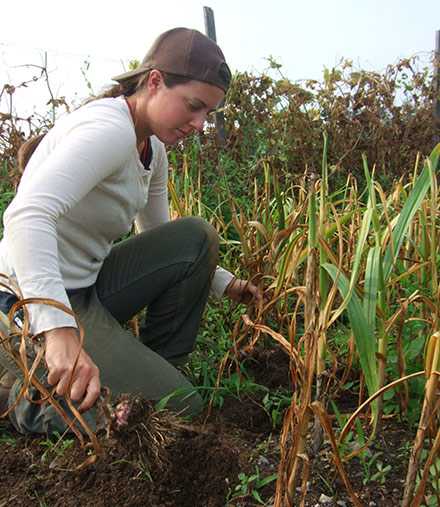Garlic, or “gah-lic” as we pronounce it here in New England, is a crop grown all over the globe—prized for adaptability to various growing conditions, medicinal benefits and of course its pungent and delicious flavor.
While you can overwinter many vegetables for spring eating, garlic is the only crop that is planted in the fall for a harvest the following summer. At Heifer Farm in central Massachusetts, we plant our garlic the first week in November, but any time in the fall would work. Aim to time your planting so that the seed has time to grow roots underground, but not sprouts above ground, before winter.
Check out other helpful garden tips from Liz.

Choose seed garlic from a trusted source or seed catalog, as disease can be transmitted from cloves and contaminate your garden soil. We have planted a variety called Overlook Red at Heifer Farm for over 20 years, the name given in homage to our previous farm name, Overlook Farm, and because of the garlic’s purple and reddish hues.
To prepare garlic for planting, choose bulbs that have qualities like size, color and flavor that you’d like to replicate because, all else being equal, the seeds will be clones of their parents.
The seeds for garlic are simply the individual cloves inside the bulbs. An easy to open the bulbs is to hold the garlic stem and twist gently. Once you have separated the cloves, the paper around them can remain on or off.
When it’s time to plant, make holes 1-4” deep and 4-6” apart. A dibble is a helpful tool for this process. We have fashioned one at Heifer Farm that makes multiple rows of properly spaced holes that makes planting over 2000 cloves quick and easy. (The “dibble dance” as we call it is where a garden intern stands and walks on the tool to press it down into the soil and has become a favorite task year after year.)
When you place a clove in the hole, always remember this phrase: pointy side up! Once all the cloves are planted and covered with soil, mulch them with 2-4 inches of hay, straw, leaves or whatever you have on hand. The mulch protects the garlic from the freeze/thaw of the winter months, which could damage the seed or even heave it out of the ground.
Now what? Well, nothing! It’s time to go inside, read seed catalogs, tap maple trees, clean tools and all of those winter garden projects. Your garlic is snug underground until springtime when green shoots will pop through the mulch, and when Part 2 on the cultivating, harvesting and storage of great garlic (or gah-lic) will appear.
No matter how you slice it (or say it), garlic is one crop worth planting this fall! Send any questions on this process to liz.joseph@heifer.org, and good luck!
